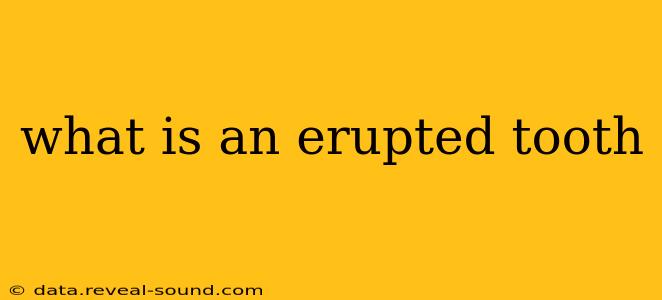An erupted tooth is simply a tooth that has broken through the gum line and is visible in the mouth. This is a normal part of dental development, and most children and adults will experience tooth eruption throughout their lives. Understanding the process of tooth eruption, potential problems, and related terms can help you maintain good oral hygiene and address any concerns promptly.
What are the stages of tooth eruption?
Tooth eruption is a gradual process. It doesn't happen overnight. Instead, it involves several stages:
- Initiation: The formation of the tooth begins beneath the gums. This phase occurs long before the tooth becomes visible.
- Eruption: This is the stage where the tooth breaks through the gum line. This is what we commonly refer to as a tooth "erupting."
- Occlusion: This is the final stage, where the tooth comes into proper contact with its opposing tooth in the upper or lower jaw. This is crucial for proper chewing and biting.
The timing of tooth eruption varies from person to person, but generally follows a predictable pattern.
What if a tooth doesn't erupt?
Sometimes, a tooth may fail to erupt completely. This is called an impacted tooth. There are various reasons why this might happen, including lack of space in the jaw, abnormal tooth positioning, or underlying medical conditions. Impacted teeth often require intervention from a dentist or orthodontist. They might need to be surgically removed or orthodontically repositioned.
How do I know if my child's tooth is erupting?
Signs that a child's tooth is erupting include:
- Swelling or redness of the gums: The gums may appear puffy and slightly red where the tooth is pushing through.
- Irritability or fussiness: The pressure of the erupting tooth can cause discomfort, leading to increased fussiness in babies and toddlers.
- Increased drooling: This is a common symptom, as the baby may be trying to soothe the irritated gums.
- Chewing or biting on objects: The baby might try to relieve the pressure and discomfort by chewing on toys or fingers.
If you have any concerns about your child's tooth eruption, it's always best to consult a dentist or pediatrician.
What are some common problems associated with tooth eruption?
While most tooth eruption is straightforward, some problems can occur, including:
- Delayed eruption: Teeth may erupt later than expected.
- Impacted teeth: As mentioned above, teeth may become trapped under the gums.
- Pericoronitis: This is an inflammation of the gum tissue around a partially erupted tooth, often a wisdom tooth. This can be painful and require professional treatment.
What should I do if I have concerns about tooth eruption?
Regular dental check-ups are crucial for monitoring tooth development and addressing any potential problems early on. If you notice any unusual signs or symptoms related to tooth eruption, don't hesitate to schedule an appointment with your dentist or orthodontist. Early intervention can prevent more serious issues from developing.
What are the differences between primary teeth and permanent teeth?
Primary teeth (also known as baby teeth or deciduous teeth) are the first set of teeth that children develop. These are eventually replaced by permanent teeth. The eruption of permanent teeth often involves the shedding of the primary teeth. Permanent teeth are larger and stronger than primary teeth and are designed to last a lifetime with proper care.
This information is for general knowledge and does not constitute medical advice. Always consult with a dental professional for any concerns regarding tooth eruption or oral health.
